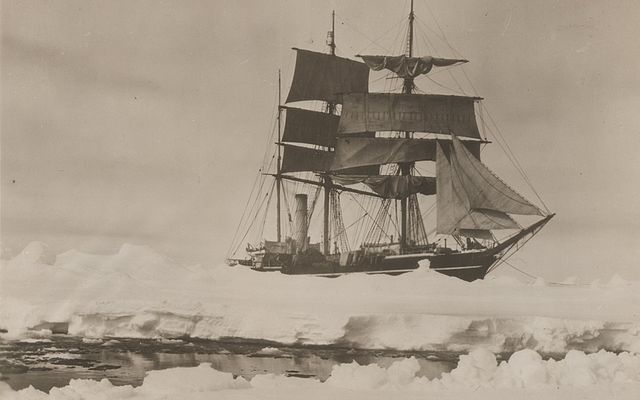Difference between revisions of "Terra Nova"
Westarctica (talk | contribs) |
Westarctica (talk | contribs) |
||
| Line 10: | Line 10: | ||
Although the twenty-four officers and scientific staff made valuable observations in biology, geology, glaciology, meteorology, and geophysics along the coast of Victoria Land and on the [[Ross Ice Shelf]], Scott's last expedition is best remembered for the death of Scott and four companions. | Although the twenty-four officers and scientific staff made valuable observations in biology, geology, glaciology, meteorology, and geophysics along the coast of Victoria Land and on the [[Ross Ice Shelf]], Scott's last expedition is best remembered for the death of Scott and four companions. | ||
After wintering at Cape Evans on [[Ross Island]], Scott, Henry Bowers, Edgar Evans, Lawrence Oates, and Edward Wilson set out on a race to be the first men at the [[South Pole]]. Starting with tractors and Mongolian ponies, the final 800 miles (1,300 km) had to be covered by man-hauling alone. Reaching the South Pole on 17 January 1912, they found that [[Roald Amundsen]]'s expedition (based on ''[[Fram]]'') had beaten them by thirty-four days. Worse was to come, as all five men died on the return journey. The frozen bodies of three were discovered eight months later, in November 1912. Their journals and papers were found and retrieved. | After wintering at Cape Evans on [[Ross Island]], Scott, Henry Bowers, [[Edgar Evans]], Lawrence Oates, and Edward Wilson set out on a race to be the first men at the [[South Pole]]. Starting with tractors and Mongolian ponies, the final 800 miles (1,300 km) had to be covered by man-hauling alone. Reaching the South Pole on 17 January 1912, they found that [[Roald Amundsen]]'s expedition (based on ''[[Fram]]'') had beaten them by thirty-four days. Worse was to come, as all five men died on the return journey. The frozen bodies of three were discovered eight months later, in November 1912. Their journals and papers were found and retrieved. | ||
==Later career== | ==Later career== | ||
Revision as of 08:45, 12 March 2022
Terra Nova was a whaler and polar expedition ship. She is best known for carrying the 1910 Terra Nova Expedition, Robert Falcon Scott's last expedition to the South Pole.
Construction
Terra Nova (Latin for "new land") was built in 1884 for the Dundee whaling and sealing fleet. She was ideally suited to the polar regions and worked for 10 years in the annual seal fishery in the Labrador Sea, proving her worth for many years before she was called upon for expedition work.
Terra Nova Expedition
In 1909, Terra Nova was bought by Captain Robert Falcon Scott of the Royal Navy for the sum of £12,500, as expedition ship for the Terra Nova Expedition of 1910. Reinforced from bow to stern with seven feet of oak to protect against the Antarctic ice pack, she sailed from Cardiff Docks on 15 June 1910 under overall command of Captain Scott. He described her as "a wonderfully fine ice ship.... As she bumped the floes with mighty shocks, crushing and grinding a way through some, twisting and turning to avoid others, she seemed like a living thing fighting a great fight."
Although the twenty-four officers and scientific staff made valuable observations in biology, geology, glaciology, meteorology, and geophysics along the coast of Victoria Land and on the Ross Ice Shelf, Scott's last expedition is best remembered for the death of Scott and four companions.
After wintering at Cape Evans on Ross Island, Scott, Henry Bowers, Edgar Evans, Lawrence Oates, and Edward Wilson set out on a race to be the first men at the South Pole. Starting with tractors and Mongolian ponies, the final 800 miles (1,300 km) had to be covered by man-hauling alone. Reaching the South Pole on 17 January 1912, they found that Roald Amundsen's expedition (based on Fram) had beaten them by thirty-four days. Worse was to come, as all five men died on the return journey. The frozen bodies of three were discovered eight months later, in November 1912. Their journals and papers were found and retrieved.
Later career
After returning from the Antarctic in 1913, Terra Nova was purchased by her former owners and resumed work in the Newfoundland seal fishery. Estimates for her career as a sealing vessel is over 800,000 seal pelts. In 1918 she was charted by the Dominion Steel and Coal Corporation to transport coal from the coal mines at North Sydney to Bell Island. She also assisted at the disaster of the SS Florizel in February 1918.
In 1942, Terra Nova was chartered by Newfoundland Base Contractors to carry supplies to base stations in Greenland. On 12 September 1943 at 2205, the vessel sent an SOS reporting damage, that water was over the boilers and pumps were not working. The US Coast Guard Cutters Atak, Amarok, Laurel, and Manitou, all part of the Greenland Patrol of the US Atlantic Fleet, responded. Atak reached Terra Nova on 13 September. They rescued all personnel aboard and set the ship alight before proceeding to Narsarssuak, Greenland. Amarok and Manitou turned back after their services were not needed. Laurel proceeded to the site of Terra Nova. The burning hulk was sunk by gunfire the same day at 60°15′15″N 45°55′45″W.
